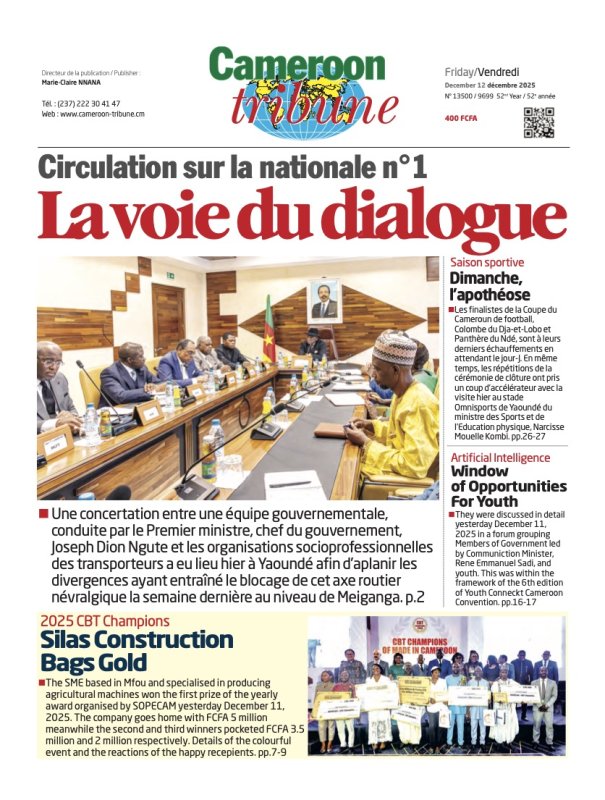Road Infrastructure: Reviewing Construction Model
- Par Godlove BAINKONG
- 14 Nov 2024 11:25
- 0 Likes
Citizens in Cameroon, like others elsewhere, have problems that differ from one individual, society or region to the other. But there is one that touches almost all of them the same way- the state of roads. The country’s national, regional and communal roads are so bad that the adverse effects leave no citizen indifferent. Those that are said to be tarred are mostly in an advanced state of dilapidation while the unpaved ones are muddy during the rainy season and dusty when the sun shines. A despicable situation that makes life rough and limits growth.
In effect, information from the Ministry of Public Works indicating that the country’s road network as at December 31, 2023 was estimated at 121,873 km, with 10,225.58 km tarred comprising: 109 km of motorways, 5,798.69 km of national roads, 1,606.08 km of regional roads and 2,711.81 km of communal roads, sound good to the ears. However, the state of these road infrastructure leaves much to be desired. Too poor to journey a country out of underdevelopment talk less of even taking it halfway to emergence. Food for thought indeed!
Without any exaggeration, Cameroon absolutely needs a “Marshall Plan” for its road development if the country hopes to realise its growth vision. Obviously from meetings here and there and pronouncements made each time any of such gatherings hold, the State Engineer in matters of civil works would tell anyone who cares to listen that the country has wonderful plans to transform its roads. They also talk of existing standards in terms of road construction. Of course, it is good to plan, but when much is said than done about vital growth catalysts like roads, or poorly done with little or no long-term vision, there is every reason to worry. The maxim that where a road passes development follows, is still very much valid.
A week ago, citizens were served with yet another office discussion, this time around on resizing pavements. In effect, against a reported backdrop that the pavement structure accounts for between 25% and 40% of the cost of road construction, and can account for more than 70% in the case of certain rehabilitation works, the Minister of Public Works launched a study to improve pavement design in the country. The State Engineer told the media during the come together that: “We are looking for solutions adapted to our context. The aim is to do more with less, which should lead us to a policy of designing, building and rehabilitating our roads in a sustainable way.” Such a declaration can ignite different interpretations on the quality of the infrastructure. But apologists justify that in a context marked by scarcity of resources in the face of immense road infrastructure needs, the goal is to identify precisely the causes of rising pavement costs, and to propose appropriate solutions to contain these costs, while maintaining the durability of the infrastructure. Reports say discussions on this subject have already led to a number of proposals. These include the projection of standard pavement structures that can be implemented with locally available materials; the development of national geotechnical standards to adapt them to the realities of the country’s geo-climatic environment and level of economic development; the development of a catalogue and a sizing guide adapted to the national context, among others.
The pretext might be convincing to some! However, as the office initiatives are many, so too are the problems of movement in the country owing to bad roads. Very few citizens would even bother to know what standards are used for what road. Their interest is in the quality of the infrastructure served them. There are complaints left and right because, the roads are poor in some areas or are lacking in others. Quite a disturbing situation for life and livelihood.
How then can a country progress when the foundation of its growth is faltered! One of the primary benefits of a good road network is improved mobility and accessibility for both urban and rural populations. For, the good roads provide individuals with the freedom to travel conveniently and access essential services such as healthcare, education, and employment.
Inasmuch as the need to develop the country’s road network remains pressing, stakeholders should as well know that it would be counter-productive to continually provide citizens with days-of-old infrastructure in a modern and fast evolving age. “Doing much with little,” as many observers hope, should not entail painting footpaths...
Cet article complet est réservé aux abonnés
Déjà abonné ? Identifiez-vous >
Accédez en illimité à Cameroon Tribune Digital à partir de 26250 FCFA
Je M'abonne1 minute suffit pour vous abonner à Cameroon Tribune Digital !
- Votre numéro spécial cameroon-tribune en version numérique
- Des encarts
- Des appels d'offres exclusives
- D'avant-première (accès 24h avant la publication)
- Des éditions consultables sur tous supports (smartphone, tablettes, PC)











Commentaires